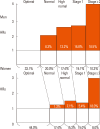Epidemiology and registry studies of stroke in Japan
- PMID: 24324936
- PMCID: PMC3779676
- DOI: 10.5853/jos.2013.15.1.21
Epidemiology and registry studies of stroke in Japan
Abstract
Stroke is the most prevalent cardiovascular disease in Japan. This review introduces two epidemiologic studies and four registry studies of stroke in Japan. The Hisayama Study was begun as a population-based prospective cohort study of cerebrovascular and cardiovascular diseases in 1961 in the town of Hisayama. Most of the deceased subjects of the study underwent autopsy examinations from the beginning of the study. Changes in stroke trends in the last 50 years were clarified by comparison of data from different study cohorts registered every 13 to 14 years. The Suita Study was based on a random sampling of Japanese urban residents. Several reports from this study showed the significance of pre-hypertension, as well as hypertension, as a risk factor for stroke by itself and in combination with other underlying characteristics. In addition, the Japan Multicenter Stroke Investigators' Collaboration (J-MUSIC), the Japan Standard Stroke Registry Study, the Fukuoka Stroke Registry, and the Stroke Acute Management with Urgent Risk-factor Assessment and Improvement (SAMURAI) rt-PA Registry are explained as registry studies involving Japanese stroke patients.
Keywords: Acute stroke; Asian; Incidence; Japan; Thrombolysis.
Conflict of interest statement
The authors have no financial conflicts of interest.
Figures



References
-
- Kim AS, Johnston SC. Global variation in the relative burden of stroke and ischemic heart disease. Circulation. 2011;124:314–323. - PubMed
-
- van Asch CJ, Luitse MJ, Rinkel GJ, van der Tweel I, Algra A, Klijn CJ. Incidence, case fatality, and functional outcome of intracerebralhaemorrhage over time, according to age, sex, and ethnic origin: a systematic review and meta-analysis. Lancet Neurol. 2010;9:167–176. - PubMed
-
- Leung TW, Kwon SU, Wong KS. Management of patients with symptomatic intracranial atherosclerosis. Int J Stroke. 2006;1:20–25. - PubMed
-
- Kubo M, Kiyohara Y, Kato I, Tanizaki Y, Katafuchi R, Hirakata H, et al. Risk factors for renal glomerular and vascular changes in an autopsy-based population survey: the Hisayama study. Kidney Int. 2003;63:1508–1515. - PubMed
-
- Ueda K, Omae T, Hirota Y, Takeshita M, Katsuki S, Tanaka K, et al. Decreasing trend in incidence and mortality from stroke in Hisayama residents, Japan. Stroke. 1981;12:154–160. - PubMed
Publication types
LinkOut - more resources
Full Text Sources
Other Literature Sources
Medical

